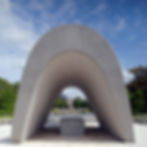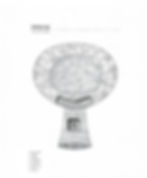Do|Co|Mo|Mo|Japan|04 : The Hiroshima Peace Centre : Kenzo Tange
- John Barr
- Nov 21, 2018
- 6 min read
Updated: Feb 5, 2021

Do|Co|Mo|Mo is an international organisation dedicated to the Documentation and Conservation of buildings, sites and neighbourhoods of the Modern Movement. The Japanese branch has selected 100 works as representative of the development of the Modern Movement in Japan.
In a series of short posts I will feature some of the selected works that I have had the chance to visit and photograph. This post features The Horoshima Peace Centre, built in 1955...
Background
The background hardly needs to be explained. In earlier posts I have covered the circumstances that led Japan into WWII. The Peace Centre (now known as the Hiroshima Peace Memorial Museum and Peace Memorial Park) commemorates the circumstances that ended the war for Japan: the first use of the atomic bomb, dropped on the city of Hiroshima on August 6 1945, resulting in the deaths of over 200,000 people, mostly civilians. The Japanese government held an architectural competition for the design of the Peace Centre, which was won by Kenzo Tange with this design.
Design
The Peace Centre was the first large scale, post-war public architectural project in Japan and Tange won the design competition with a proposal that included a museum building that was the concrete realisation of Corbusier’s Five Points of A New Architecture together with structures for a cenotaph and a commemorative flame, all set within a classical composition created around a formal axis running between the centre point of the A-Bomb Dome* and the centre line of the museum.
* The A-Bomb Dome (officially the Peace Memorial) refers to the steel skeleton of the dome that sits on top of the destroyed Hiroshima Prefectural Industrial Promotion Hall, the only building left standing, as a ruin, near the epicentre of the explosion.

The Hiroshima Peace Centre, Kenzo Tange, 1955
The Museum : the concrete realisation of Corbusier's Five Points of a New Architecture

The Hiroshima Peace Memorial (also known as the A-Bomb Dome) photographed August 5 1949
The ruins of the Hiroshima Prefectural Industrial Promotion Hall, originally designed by Jan Letzel, 1915
Note the poster promoting "Peace Forever" and "Peace Day" (Image from Associated Press)1

The Hiroshima Peace Centre, Kenzo Tange, 1955
Pictured on August 6 1963: View from the Peace Museum with the formal axis running to the Peace Memorial (the A-Bomb Dome). The Cenotaph is in the centre of shot (Image from Associated Press)1
Ever the politician, Tange had adopted western principles that would show Japan as a modern, outward-looking nation, ready to re-join the international community. This was quite a transformation from the war-time Tange whose winning entry for the 1942 competition for the Greater East Asia Memorial Building was based on ancient Japanese imperial symbols, and who declared that Japan should ignore western ideas and develop a new Japanese architectural style that was: sublime and powerful like God, brave and solemn like a giant.
However, like an extreme nationalist politician who moves to a more mainstream party and moderates his rhetoric whilst employing coded euphemisms designed to appeal to his nationalist support base, Tange insisted that his apparently modern, western design contained coded elements from traditional Japanese precedents: the plan of Byōdō-in’s Amida-do (also known as Hō-ō-do or the Phoenix Hall) and the column ratios of Katsura Imperial Villa. As the Japanese architect Arata Isozaki has put it: The way modernist and nationalist themes were combined (in Tange's design) had been subtle indeed.2
Subtle indeed – so subtle as to go unnoticed had Tange not drawn our attention to it. The reference to the Amida-do simply means that the plan was symmetrical around a central axis. Tange chose to quote a recognised cultural asset as his model (the Amida-do adorns the Japanese 10 yen coin) but, in truth, his plan is no more closely related to this than to a number of historic precedents, both eastern and western. As for the reference to the column ratios of Katsura Imperial Villa, it is not clear exactly what this means and a visual comparison of the two buildings doesn't make the correlation more evident but, in a sense, this is unimportant. As I have noted in previous posts, Katsura Imperial Villa, along with Ise Shrine, was one of the two precedents that it was useful to reference in order to stay 'on message' with the aims of the Japanese government of the time and, in the mere act of stating it as a reference, along with the Amida-do, Tange again shows his political astuteness.

The Hiroshima Peace Centre, Kenzo Tange, 1955
The Museum : referencing the plan of Byōdō-in's Amida Hall and the column ratios of Katsura Imperial Villa according to Tange

The Hiroshima Peace Centre, Kenzo Tange, 1955
The Peace Flame : lying on the axis that runs from the Peace Memorial (the A-Bomb Dome) to the Museum, with the Museum in the background

The Hiroshima Peace Centre, Kenzo Tange, 1955
The Peace Cenotaph : with the Peace Flame and the Peace Memorial (the A-Bomb Dome) in the background

The Hiroshima Peace Centre, Kenzo Tange, 1955
The Peace Cenotaph and the Peace Museum viewed from under the Peace Flame
Compare and Contrast
It is interesting to contrast Tange’s design with another of the competition entries, by Seiichi Shirai. Shirai’s personality was almost the polar opposite to Tange’s. Where Tange was the consummate insider and well-connected political operator, Shirai was a determined individualist with a reputation for being difficult and arrogant. However, in the case of the competition to design the Hiroshima Peace Centre, both architects seem to have designed one thing whilst claiming to have designed something else. Tange produced a design based on orthodox western modernist values whilst claiming that he had subverted these values by the insertion of coded elements drawn from Japan’s past. Shirai, on the other hand, claimed to have produced an eternal, collective symbol of hope whilst, in fact, subverting that image.
At first I pursued an image of deep sadness, a lone building standing on a bleak plain. It was associated with memories of brutal violence, the idea of a desolate ruin. As I continued to think about this problem, I eventually moved away from this narrative mode of thinking. I came to believe that the only way to proceed was to explore the possibilities of a priori factors…It was difficult to design an eternal, collective symbol of hope rather than a metaphor defining the memory of the tragedy, but I did this because I thought that the most important thing was to obtain a formal purity that had never appeared before human eyes in the past.3
Shirai claims to have been pursuing eternal (universal) values, precisely of the type promoted by the Euclidean modernism apparent in Tange’s design, whilst actually adopting the narrative mode that he claims to have abandoned. This is apparent in his proposal, where it is difficult to read his design for the Museum building as anything other than an abstracted image of an atomic mushroom cloud emerging from the water that surrounds it. This must be seen in the context of the USA's continued testing of increasingly powerful nuclear devices on Bikini Atoll, despite the horror of Hiroshima.

The Hiroshima Peace Centre, Competition Entry, Seiichi Shirai,1955
It is difficult to read the museum building as anything other than an abstracted representation of an atomic mushroom cloud. Even the approach through a tunnel and chamber that run beneath the pond conjures up images of nuclear shelters (Image from Shirai : Anima et Persona)3

Hydrogen bomb testing on Bikini Atoll, begun by the USA in 1946, one year after Hiroshima (Image from AP)
Shirai’s masterplan for his competition entry is not even an abstract image; it is clearly a representation of a mushroom cloud. But, like the Nazca lines in the Peruvian desert, one that would only be seen from a great height, such as from the vantage point of the gods, or the pilot of a B29 bomber.

The Hiroshima Peace Centre, Competition Entry, Seiichi Shirai,1955
Master Plan: clearly a representation of an atomic mushroom cloud (Image from Shirai : Anima et Persona)3
Both Tange and Shirai seem to have been disingenuous, each saying one thing whilst doing another, and it is interesting to contrast their strategies and guess at their motivations. Tange conformed to the image of the new, international Japan, whilst claiming to be subversive, like a practised politician playing to different audiences. Shirai claimed to be seeking a collective symbol of hope that surpassed narrative, whilst actually creating a subversive visual joke that, given his personality, was probably for his own amusement.
1. Image taken from 69 years after Hiroshima, a look at the dome that survived, Nick
Kirkpatrick, article in The Washington Post, August 6, 2014.
2. Japan-ness in Architecture, Arata Isozaki, translated by Sabu Kohso, MIT Press, 2011.
3. Shirai : Anima et Persona, Seiichi Shirai, Seigensha Art Publishing, 2010.
